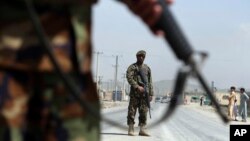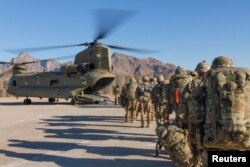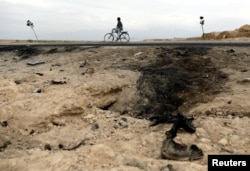The U.S.-led NATO mission in Afghanistan is no longer collecting data showing the Afghan government steadily losing ground to the Taliban, telling a U.S. government watchdog the information was “of limited decision-making value.”
The so-called district-level stability assessments, which measure the number of the country’s districts under government or insurgent control or influence, have been one of the most widely cited indicators of U.S. strategy in Afghanistan.
But the U.S.-commanded Resolute Support mission told the Special Inspector General for Afghanistan Reconstruction (SIGAR) in March the assessments were no longer being produced.
“District stability data has not been collected since the October 22, 2018 data submitted last quarter,” Resolute Support wrote in response to SIGAR’s request for the information ahead of its latest report, released Wednesday.
“There are no products at command or other forums that communicate district stability or control information,” the letter added.
According to SIGAR, U.S. defense officials also said the assessments were “not indicative of effectiveness of the South Asia strategy or of progress toward security and stability.”
The SIGAR quarterly report also quoted defense officials as saying it was “more important to instead focus on the principal goal of the strategy of concluding the war in Afghanistan on terms favorable to Afghanistan and the United States.”
When asked for about the decision to end the assessments, a spokesman for Resolute Support referred VOA to the letter sent to the special inspector general.
In a statement accompanying the report’s release, SIGAR decried the loss of the data.
“Despite its limitations, the control data was the only unclassified metric provided by [Resolute Support] that consistently tracked changes to the security situation on the ground,” SIGAR said.
SIGAR also noted that previous commanders of the Resolute Support mission “had previously cited its importance in public statements.”
The U.S.-led mission’s decision to eliminate the stability assessments comes after successive reports showed the Afghan government’s control of the country falling to record lows.
Low levels of control, influence
In its November 2018 report, SIGAR said the Afghan government controlled or influenced only 56 percent of the country’s districts, at the time the lowest level recorded since the watchdog began tracking district control in November 2015.
In SIGAR’s subsequent report, issued this past January, that number had slipped to less than 54 percent, as the Afghan government lost seven districts to the Taliban.
According to some, the figures suggest U.S. President Donald Trump's strategy for Afghanistan, meant to increase pressure on the Taliban and force them to negotiate an end to decades of fighting, is not having the level of success claimed by administration officials.
Other data collected for the latest SIGAR report also show reason for concern.
According to Resolute Support, the average number of attacks initiated by the Taliban jumped 19 percent for the three-month period ending in January. And according to U.S. Forces-Afghanistan, the number of casualties suffered by Afghan forces were 31 percent higher than compared to the same period last year.
“Ultimately, I don’t think we’ve met all of our strategic goals there,” U.S. Special Inspector General for Afghanistan Reconstruction John Sopko told reporters last week, ahead of the report’s release.
“We were going to get the terrorists out and create a government that could keep the terrorists out,” he said. “Obviously, we haven’t kicked the terrorists out if they’re still blowing things up and we’re negotiating with them. That strategic goal has now changed.”
Sopko also raised concerns that measuring U.S. progress in Afghanistan has become increasingly difficult, as U.S. and Afghan officials are collecting less data and are preventing other information from going public.
“What we are finding now is almost every indicia, metrics, however you want to phrase it, for success or failure is now classified or non-existent,” he said, adding that hiding or eliminating would appear pointless.
“The Afghan people obviously know which districts are controlled by the Taliban. The Taliban obviously know which districts they control. Our military knows it. Everybody in Afghanistan knows it,” he said. “The only people who don’t know what is going on are the people who are paying for all of this, and that’s the American taxpayer.”












